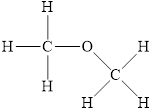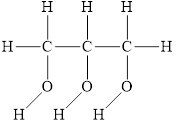
(a)
Interpretation:
The intermolecular interactions that operate in
Concept introduction:
There are three types of interactions through which the molecules are stabilized. They are hydrogen-bonding interactions, the dipole-dipole interactions and the induced dipole interactions. These interactions influence the properties of the compounds like boiling point, melting point and so on.
Answer to Problem 39E
The intermolecular interactions that operate in
Explanation of Solution
In all molecular substances, the intermolecular interactions exist. These interactions are induced dipole interactions, dipole-dipole interactions and hydrogen bonding.
The structure of

Figure 1
The molecule has electronegative atom
The intermolecular interactions that operate in
(b)
Interpretation:
The intermolecular interactions that operate in
Concept introduction:
There are three types of interactions through which the molecules are stabilized. They are hydrogen-bonding interactions, the dipole-dipole interactions and the induced dipole interactions. These interactions influence the properties of the compounds like boiling point, melting point and so on.
Answer to Problem 39E
The intermolecular interactions that operate in
Explanation of Solution
In all molecular substances, the intermolecular interactions exist. These interactions are induced dipole interactions, dipole-dipole interactions and hydrogen bonding.
The structure of

Figure 2
The molecule has electronegative atom
The intermolecular interactions that operate in
(c)
Interpretation:
The intermolecular interactions that operate in
Concept introduction:
There are three types of interactions through which the molecules are stabilized. They are hydrogen-bonding interactions, the dipole-dipole interactions and the induced dipole interactions. These interactions influence the properties of the compounds like boiling point, melting point and so on.
Answer to Problem 39E
The intermolecular interactions that operate in
Explanation of Solution
In all molecular substances, the intermolecular interactions exist. These interactions are induced dipole interactions, dipole-dipole interactions and hydrogen bonding.
The structure of

Figure 3
The molecule has electronegative atom
The intermolecular interactions that operate in
(d)
Interpretation:
The intermolecular interactions that operate in
Concept introduction:
There are three types of interactions through which the molecules are stabilized. They are hydrogen-bonding interactions, the dipole-dipole interactions and the induced dipole interactions. These interactions influence the properties of the compounds like boiling point, melting point and so on.
Answer to Problem 39E
The intermolecular interactions that operate in
Explanation of Solution
In all molecular substances, the intermolecular interactions exist. These interactions are induced dipole interactions, dipole-dipole interactions and hydrogen bonding.
The structure of

Figure 4
The molecule has electronegative atom
The intermolecular interactions that operate in
(e)
Interpretation:
The intermolecular interactions that operate in
Concept introduction:
There are three types of interactions through which the molecules are stabilized. They are hydrogen-bonding interactions, the dipole-dipole interactions and the induced dipole interactions. These interactions influence the properties of the compounds like boiling point, melting point and so on.
Answer to Problem 39E
The intermolecular interactions that operate in
Explanation of Solution
In all molecular substances, the intermolecular interactions exist. These interactions are induced dipole interactions, dipole-dipole interactions and hydrogen bonding.
The structure of

Figure 5
The molecule does not have any has electronegative atom. This means the polarity is not present in the molecule. This molecule can form bond with other molecule through the induced dipole interactions. Therefore, the dominant intermolecular interaction in this molecule is induced dipole interaction.
The intermolecular interactions that operate in
Want to see more full solutions like this?
Chapter 15 Solutions
Bundle: Introductory Chemistry: An Active Learning Approach, 6th + OWLv2, 1 term (6 months) Printed Access Card
- 1. Part 1: Naming Organic Compounds он H₁C-C-CH3 CH3 Br CI CI 2. Br-CH-CH-CH₂ H₂C-CH-C= -CH-CH2-CH3 3. HC-CH-CH-C-OH 5. H₂C-CH-CH₂-OH 7. OH 4. CH CH₂-CH₂ 6. сно CH-CH-CH-CH₂-CH₂ H₁₂C-CH-CH-CH-CH₁₂-CH₁₂ 8. OHarrow_forward11 Organic Chemistry Organic Nomenclature Practice Name/Functional Group n-butane Formula Structural Formula (1) C4tt10 H3C C- (2) CH3CH2CH2 CH 3 H₂ -CH3 Н2 name & functional group (1) and (2) OH H₁₂C Н2 name only (1) and (2) name only (1) and (2) H₁C - = - CH₂ Н2 HC=C-C CH3arrow_forwardUnder aqueous basic conditions, nitriles will react to form a neutral organic intermediate 1 that has an N atom in it first, and then they will continue to react to form the final product 2: NC H₂O он- H₂O 1 2 OH Draw the missing intermediate 1 and the final product 2 in the box below. You can draw the two structures in any arrangement you like. Click and drag to start drawing a structure.arrow_forward
- Assign these COSY Spectrumarrow_forwardAssign these C-NMR and H-NMR Spectrumarrow_forwardPredict the product of this organic reaction: IZ + HO i P+H₂O Specifically, in the drawing area below draw the skeletal ("line") structure of P. If there is no reasonable possibility for P, check the No answer box under the drawing area. No Answer Click and drag to start drawing a structure. ☐ :arrow_forward
- Predict the products of this organic reaction: 0 O ----- A + KOH ? CH3-CH2-C-O-CH2-C-CH3 Specifically, in the drawing area below draw the condensed structure of the product, or products, of this reaction. (If there's more than one product, draw them in any arrangement you like, so long as they aren't touching.) If there aren't any products because this reaction won't happen, check the No reaction box under the drawing area. No reaction Click anywhere to draw the first atom of your structure. X ⑤ èarrow_forwardPredict the products of this organic reaction: O CH3 + H2O + HCI A A? CH3-CH2-C-N-CH3 Specifically, in the drawing area below draw the condensed structure of the product, or products, of this reaction. If there's more than one product, draw them in any arrangement you like, so long as they aren't touching. If there aren't any products because this reaction won't happen, check the No reaction box under the drawing area. No Reaction Click anywhere to draw the first atom of your structure.arrow_forwardWhat is the missing reactant in this organic reaction? R+ HO-C-CH2-CH3 0= CH3 CH3 —CH, C−NH—CH CH3 + H₂O Specifically, in the drawing area below draw the condensed structure of R. If there is more than one reasonable answer, you can draw any one of them. If there is no reasonable answer, check the No answer box under the drawing area. Note for advanced students: you may assume no products other than those shown above are formed. No Answer Click anywhere to draw the first atom of your structure. €arrow_forward
- 个 CHEM&131 9267 - $25 - Intro to Mail - Hutchison, Allison (Student x Aktiv Learnin https://app.aktiv.com Draw the product of the reaction shown below. Ignore inorganic byproducts. + Na2Cr2O7 Acetone, H2SO4 Type here to search Dryng OH W Prarrow_forwardPredict the products of this organic reaction: OH + NaOH A? Specifically, in the drawing area below draw the skeletal ("line") structure of the product, or products, of this reaction. (If there's more than one product, draw them in any arrangement you like, so long as they aren't touching.) If there aren't any products because this reaction won't happen, check the No reaction box under the drawing area. No reaction Click and drag to start drawing a structure. ✓ Sarrow_forwardPredict the products of this organic reaction: CH3-C-O-CH2-CH2-C-CH3 + H₂O ? A Specifically, in the drawing area below draw the condensed structure of the product, or products, of this reaction. (If there's more than one product, draw them in any arrangement you like, so long as they aren't touching.) If there aren't any products because this reaction won't happen, check the No reaction box under the drawing area. No reaction Click anywhere to draw the first atom of your structure. :☐ darrow_forward
 Introductory Chemistry: An Active Learning Approa...ChemistryISBN:9781305079250Author:Mark S. Cracolice, Ed PetersPublisher:Cengage Learning
Introductory Chemistry: An Active Learning Approa...ChemistryISBN:9781305079250Author:Mark S. Cracolice, Ed PetersPublisher:Cengage Learning World of Chemistry, 3rd editionChemistryISBN:9781133109655Author:Steven S. Zumdahl, Susan L. Zumdahl, Donald J. DeCostePublisher:Brooks / Cole / Cengage Learning
World of Chemistry, 3rd editionChemistryISBN:9781133109655Author:Steven S. Zumdahl, Susan L. Zumdahl, Donald J. DeCostePublisher:Brooks / Cole / Cengage Learning World of ChemistryChemistryISBN:9780618562763Author:Steven S. ZumdahlPublisher:Houghton Mifflin College Div
World of ChemistryChemistryISBN:9780618562763Author:Steven S. ZumdahlPublisher:Houghton Mifflin College Div Introductory Chemistry: A FoundationChemistryISBN:9781337399425Author:Steven S. Zumdahl, Donald J. DeCostePublisher:Cengage Learning
Introductory Chemistry: A FoundationChemistryISBN:9781337399425Author:Steven S. Zumdahl, Donald J. DeCostePublisher:Cengage Learning Chemistry: The Molecular ScienceChemistryISBN:9781285199047Author:John W. Moore, Conrad L. StanitskiPublisher:Cengage Learning
Chemistry: The Molecular ScienceChemistryISBN:9781285199047Author:John W. Moore, Conrad L. StanitskiPublisher:Cengage Learning Principles of Modern ChemistryChemistryISBN:9781305079113Author:David W. Oxtoby, H. Pat Gillis, Laurie J. ButlerPublisher:Cengage Learning
Principles of Modern ChemistryChemistryISBN:9781305079113Author:David W. Oxtoby, H. Pat Gillis, Laurie J. ButlerPublisher:Cengage Learning





